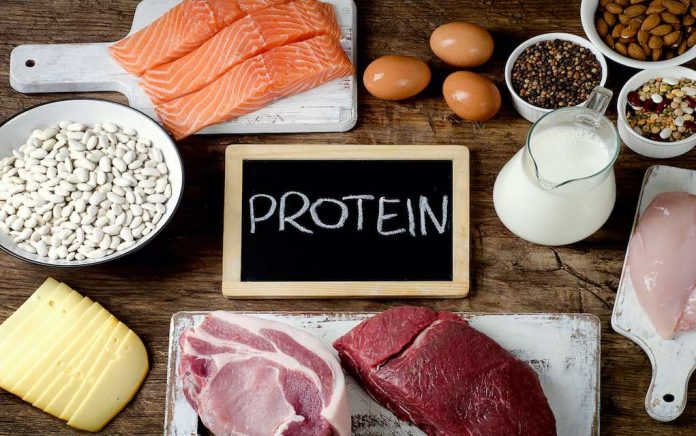
A healthy, well-balanced diet is more important during and after menopause than at any other stage of life. The body’s nutritional needs change during menopause. Shifts in hormones, body composition, and mood mean the diet a person once swore by likely isn’t working anymore.
The Relationship Between Protein and Hormones
Throughout any period of physical change, protein is a key ingredient. Many hormones are made from protein, including sex hormones, thyroid and adrenal hormones, insulin, and glucagon. Each of these hormones plays an important role during menopause and can dramatically affect energy levels, metabolism, and health.
Estrogen and progesterone affect how cells respond to insulin. After menopause, changes in the levels of these hormones can trigger more severe fluctuations in blood glucose levels, potentially increasing a woman’s risk of developing diabetes. Including some protein with each meal stimulates insulin production and helps to balance blood sugar levels, preventing the sudden rise and fall of blood glucose that a carbohydrate-based meal can cause.
When estrogen levels decline, women experience a progressive decrease in muscle mass (sarcopenia), strength, and bone density. As a result, they become more susceptible to falling, fractures, and osteoporosis. Exercise becomes more important than ever, but it is more challenging to maintain weight and muscle tone. In people of all ages, protein helps maintain muscle mass.
Natural Hormone Solutions for Perimenopause with Suzanne Somers
How Much Protein Do We Need During Menopause
To combat sarcopenia and accommodate for other hormonal and physical changes, the body’s protein needs increase during menopause. Healthy older adults should consume 1 to 1.2 grams of protein per kilogram of body weight daily—more than the recommended intake of 0.8 grams of protein per kilogram of body weight for younger adults. Based on the higher recommendation, a 150 lb (68 kg) female should aim for a protein intake of 68 to 82 grams per day (some experts have even recommended up to 100 grams).
The Right Protein Options
High-quality proteins are found in meats, poultry, fish, dairy products, nuts, seeds, legumes, and in smaller quantities, starches, and vegetables. Sprouting grains increase their protein content.
Protein powders are a convenient and healthy way to boost intake of this essential nutrient. While whey protein has been considered the gold standard of protein supplements, pea protein’s arginine content is almost three times higher. The amino acid is essential for building and maintaining muscle mass and might be a better option for women during mid-life.
Read 5 Surprising Ways to Use Protein Powder
| FOOD SOURCE | AMOUNT PROTEIN |
| Lean meats, poultry, eggs: | Per 3-ounce serving (unless otherwise stated) |
| Skinless chicken breast
Yellowfin tuna Lean ground beef Turkey breast Lean pork Sockeye salmon Rainbow trout Eggs
|
26 grams
25 grams 25 grams 24 grams 22 grams 22 grams 17 grams 6 grams per large egg |
| Dairy products: | |
| Greek yogurt
Cottage cheese Parmesan cheese Milk (skim, 1%, 2%, whole) Swiss cheese Mozzarella cheese (whole milk) |
20 grams (1 cup serving)
14 grams (1/2 cup serving) 10 grams (1 ounce) 8 grams (1 cup) 7.6 grams (1 ounce) 6.3 grams (1 ounce) |
| Legumes and other plant-based foods: | |
| Firm tofu
Lentils (boiled) Hemp Hearts Chickpeas (boiled) Kidney beans (boiled) Walnuts Pumpkin seeds Almonds Dry roasted chickpeas Quinoa Peanut butter Almond butter Avocado Hummus |
17 grams
12 grams (1/2 cup) 10 grams (3 tbsp.) 7.5 grams (1/2 cup) 7.5 grams (1/2 cup) 7.5 grams (1/4 cup) 7.25 grams (1/4 cup) 7 grams (1/4 cup) 6 grams (1/3 cup) 4 grams (1/2 cup cooked) 4 grams (1 tbsp.) 3.4 grams (1 tbsp.) 2.7 grams (1 avocado, 136 grams) 2 grams (2 tbsp.) |
When to Eat Your Protein
Just as important as the overall amount of protein is its distribution throughout the day. The body can use only 25 to 35 grams of protein every four to five hours. When too much protein is consumed, the excess is excreted via the urine. That means, overloading on protein by eating a 6-ounce steak or adding an extra scoop of protein powder to a shake won’t help. Instead, consuming protein throughout the day minimizes protein losses and maximizes its efficiency.
Example Menu to Reach Your Protein Goals
Here is an example of a menu that prioritizes protein:
| Meal | Amount Protein | |
| Breakfast: | Smoothie made with 1 scoop of protein powder | 25 grams |
| Snack: | Fresh fruit sprinkled with hemp hearts | 10 grams |
| Lunch: | Lentil soup, 1 cup | 9 grams |
| Snack: | Almonds, handful | 7 grams |
| Dinner: | 3 oz. grilled salmon, ½ cup quinoa, 1 cup green salad | 27 grams |
| TOTAL | 78 grams protein | |
Read 6 Powerhouse Vegetables to Add to Your Grill
The Bottom Line
Balance quality protein foods with plenty of colorful and cruciferous vegetables, fruit, healthy fats—including omega-3, an essential fatty acid that can help manage menopausal symptoms and reduce inflammation, and prebiotics and probiotic food sources to protect gut health.










